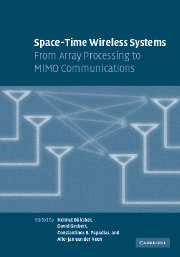Book contents
- Frontmatter
- Contents
- List of contributors
- Acknowledgments
- Introduction
- Part I Multiantenna basics
- Part II Space-time modulation and coding
- Part III Receiver algorithms and parameter estimation
- Part IV System-level issues of multiantenna systems
- 18 MIMO Gaussian multiple access channels
- 19 On information-theoretic aspects of MIMO broadcast channels
- 20 Multiuser MIMO systems
- 21 Opportunistic communication: a system view
- 22 System level performance of MIMO systems
- Part V Implementations, measurements, prototypes, and standards
- Index
18 - MIMO Gaussian multiple access channels
Published online by Cambridge University Press: 25 February 2010
- Frontmatter
- Contents
- List of contributors
- Acknowledgments
- Introduction
- Part I Multiantenna basics
- Part II Space-time modulation and coding
- Part III Receiver algorithms and parameter estimation
- Part IV System-level issues of multiantenna systems
- 18 MIMO Gaussian multiple access channels
- 19 On information-theoretic aspects of MIMO broadcast channels
- 20 Multiuser MIMO systems
- 21 Opportunistic communication: a system view
- 22 System level performance of MIMO systems
- Part V Implementations, measurements, prototypes, and standards
- Index
Summary
From the earliest days of multiuser information theory (Ahlswede, 1971), multiple access channels (MACs) have assumed a prominent role and profited from the development of a rich theory. Recent years have seen these theoretical results find manifest application in MIMO fixed wireless, cellular voice/data uplink, “vectored” upstream DSL, and wireless LAN standards, to name only a few. The rapid pace of research and development continues in earnest, where both techniques to implement classical results as well as developing extensions to novel channel scenarios are of interest.
This chapter surveys classical and modern theoretical aspects of multiple access channels that are germane to the design of MIMO communications systems. The emphasis is upon design principles that arise naturally from information-theoretic considerations; to this end, it is fitting to focus on a class of MACs termed Gaussian MACs, for which a diverse body of literature exists under numerous channel scenarios. Detailed proofs of the results may be found in the references contained herein.
Channel models are considered in a paradigm of space, frequency, and time. The “space” dimension refers to the number of users and number of channel inputs and outputs (e.g., transmit and receive antennas), and their correlation. The “frequency” dimension refers to frequency-selectivity present in the channel. Finally, “time” refers to time-dependence of the channel process (i.e., fading). As one might expect, the qualitative results vary considerably based on the scenario being studied; more surprisingly, there are many commonalities that arise.
- Type
- Chapter
- Information
- Space-Time Wireless SystemsFrom Array Processing to MIMO Communications, pp. 365 - 384Publisher: Cambridge University PressPrint publication year: 2006



